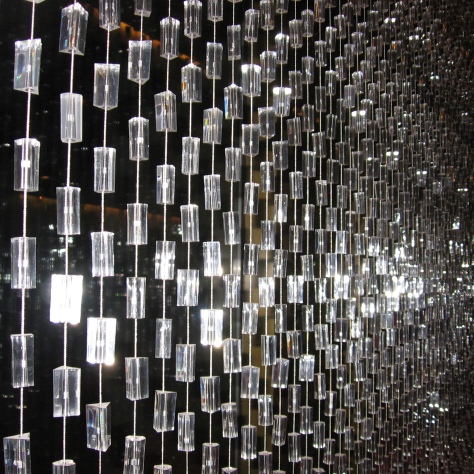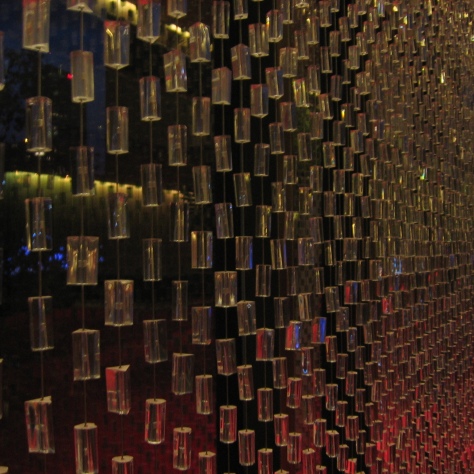Howdy!
One of my favorite Montreal sculptures is Comme si le temps… de la rue by Pierre Granche. Unfortunately, in the most recent set of renovations to what used to be the Hall des Pas perdus of Place des Arts, but that they now call Espace culturel Georges-Émile-Lapalme they have just about killed it.

A little background; back in the early 90’s the Musée d’art contemporain de Montréal was planning on moving from Cité du Havre to downtown and getting themselves a brand spanking new building in the process. As the law stipulated, 1% of the project had to be dedicated to creating art. Even if it was a museum they still had to make more art specifically for the place (that’s one of the things I like most in theory about the 1% for art law, is that it ends up creating site specific work).
Anyhows, Pierre Granche [pdf alert] a sculptor and a teacher (he was one of the people responsible for the Universite de Montreal‘s visual arts department – and now that he’s dead, they no longer have one. Make of that what you will…) submitted a proposal and won. (I’m still going to have to try and find out who was one the jury.) And in 1992, what ended up getting built was Comme si le temps… de la rue.

Basically it was a bunch of aluminum cutouts in a semi circle with a waterfall. It was open to the sky and viewable from the esplanade of Place des Arts, which gave a viewer the chance to have a complete overview of the entire piece (which is not a small piece by any stretch of the imagination). And there is a skylight looking down into the Musée d’art contemporain de Montréal’s restoration workshops.
[Old pictures here, here, here, and here]
I never gave it much thought, always figuring that at some time in the future I would hunker down and give it the time, energy and thought that it required.
Well that time is now (actually, Sunday night, as I try to write these posts in advance of posting them). Because I was passing by over the weekend and from where I sit the powers that be (in reality Consortium Menkès, Schooner, Dagenais, Le Tourneux/Provencher, Roy Jean-Pierre Le Tourneux, concepteur Claude Bourbeau, chargé de projet) have completely and thoroughly killed, destroyed, ruined and entirely screwed up Comme si le temps… de la rue [pdf alert] by Pierre Granche.
In short, by placing a roof over it and turning off the waterfall, they have stripped the sculpture of all meaning, significance and comprehensibility. it is now no more than the equivalent of a fancy-ass and extremely expensive indoor lawn ornament for the Deschamps bar at Place des Arts.

From the seats at the the Deschamps bar, it is completely and thoroughly impossible to get any perspective on the piece. By being so close to it, you literally can’t see the forest for the trees.

The roof of the bar prevents you from seeing the tops of the sculptures. And by being so close you can no longer gain any perspective on the base. And perspective was what Comme si le temps… de la rue was all about. There are two extremely large and two merely large aluminum sculptures that depending on which way you swing could represent either the ancient Egyptian god Sobek, or the ancient Egyptian god Set. There are also a couple of construction cranes, and seven things, that again (depending on which way you swing) could either be some sort of vaguely sphinx-like objects, or if you squint really heard could be viewed as some kind of deer or reindeer-like domesticated animal.

My quick and dirty translation of the plaque for the blokes in the house
Pierre Granche’s installation offers a mythical vision of Montreal. Inspired from Greek Theatre and Egyptian iconography, it works a representation of the urban fabric between Mount Royal and the St. Lawrence River through the use of a waterfall. Sculptured female figures used as a columns in an Egyptian style with bird’s heads refer to the history of art and architecture in a totem pole fashion. The sphinxes with deer antlers make their presence known on the outskirts of a city in action. And finally, the bird’s eye view of the work was from the esplanade of Place des Arts Preview, reflects the city as the top of Mont Royal.
OK, how many mistakes can you spot? If I were a tourist wandering through Espace culturel Georges-Émile-Lapalme I’d be scratching my head in wonder, trying to figure out what the heck they were talking about. Waterfall? Bird’s eye view? There ain’t none, no more.
And while I’m at it, there isn’t any Greekness (theatre or iconography or anything else) in the piece. When they are writing in French they use the word cariatides or in squarehead speak: caryatid, or in plain English “a sculpted female figure serving as an architectural support taking the place of a column or a pillar supporting moldings and bands on her head.” (Thanks Wikipedia!) And they speak of it as the parts that are Greek. One problem though, a column by definition supports something. And these objects don’t support a darn thing. Comme si le temps… de la rue is 100% Egyptian in its influences.

And as long as I am disputing the “official” wall plaque. Those aren’t deer antlers on the sphinxes either. I don’t think that there ever was a 37 point buck that ever lived… anywhere.

However, if you go with the idea that the two extremely large and the two merely large sculptures are representations of the Egyptian god Set, the god of chaos and foreign lands. Then I think we’re getting someplace. The early 1990s in Quebec were a volatile place. Quebec was on the cusp of a referendum to separate, the Bloc Quebecois were founded in 1991. In between 1990 and 1993 there were 46 major buildings built in Montreal. The Montreal Expos were sold in 1991 and subsequently became one of the best teams in major league baseball in the early 1990s. 1992 was also the 375th anniversary of the founding of Montreal. There were a ton of things happening in Montreal at the time and there was most definitely a sense of chaos in the air (if you don’t trust me, ask someone else who lived here then).

Also if you look closely, on each of the Sets, there is a cityscape, with some sort of root structure. I’m not quite certain what to make of the root structures. But if you flip them upside down, they become the deer antlers on the sphinxes. And there are no known instances of deer appearing in ancient Egypt. But maybe, kind of, perhaps it has something to do with some sort of family tree-like structure? I dunno.
But we’re getting off the point here. Comme si le temps… de la rue is all about Montreal. There’s a representation of the mountain on the largest Set, and the waterfall was a direct reference to the river.



And while we’re showing lots of pictures, here are some of it from above.



And then in consideration of the unilingual people in the house, Comme si le temps… de la rue translates as “As if time… from the street.” You can fill in the blank yourself, but by referring back to ancient Egyptian times Granche endows Montreal with a similar sense of history. Despite it being made when Montreal was only 350 years-old, if you squint hard enough (or maybe click your heels three times or go to the Neighborhood of Make-Believe) you can pretend that Montreal has been around for more than 5,000 years, just like Egypt.
Then my last question is, if it was made for the construction of the Musée d’art contemporain de Montréal and is directly on top of their restoration workshops, why does it belong to the Place des Arts collection? Shouldn’t it belong to the Musée d’art contemporain de Montréal?












